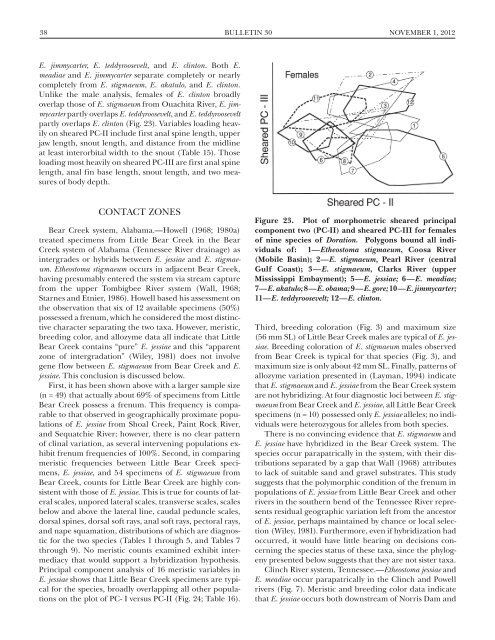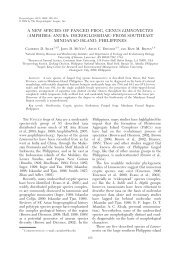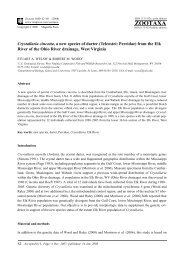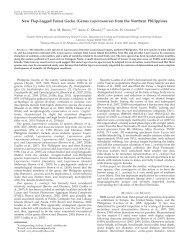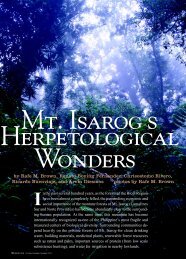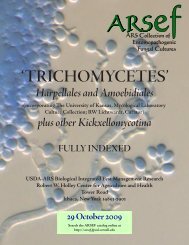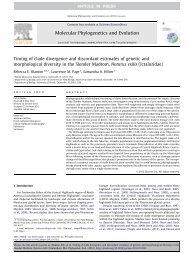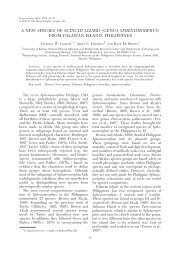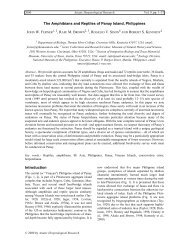(Percidae: Etheostoma), with Descriptions of Five New Species
(Percidae: Etheostoma), with Descriptions of Five New Species
(Percidae: Etheostoma), with Descriptions of Five New Species
- No tags were found...
You also want an ePaper? Increase the reach of your titles
YUMPU automatically turns print PDFs into web optimized ePapers that Google loves.
38 Bulletin 30 NOVEMBER 1, 2012E. jimmycarter, E. teddyroosevelt, and E. clinton. Both E.meadiae and E. jimmycarter separate completely or nearlycompletely from E. stigmaeum, E. akatulo, and E. clinton.Unlike the male analysis, females <strong>of</strong> E. clinton broadlyoverlap those <strong>of</strong> E. stigmaeum from Ouachita River, E. jimmycarterpartly overlaps E. teddyroosevelt, and E. teddyrooseveltpartly overlaps E. clinton (Fig. 23). Variables loading heavilyon sheared PC-II include first anal spine length, upperjaw length, snout length, and distance from the midlineat least interorbital width to the snout (Table 15). Thoseloading most heavily on sheared PC-III are first anal spinelength, anal fin base length, snout length, and two measures<strong>of</strong> body depth.CONTACT ZONESBear Creek system, Alabama.—Howell (1968; 1980a)treated specimens from Little Bear Creek in the BearCreek system <strong>of</strong> Alabama (Tennessee River drainage) asintergrades or hybrids between E. jessiae and E. stigmaeum.<strong>Etheostoma</strong> stigmaeum occurs in adjacent Bear Creek,having presumably entered the system via stream capturefrom the upper Tombigbee River system (Wall, 1968;Starnes and Etnier, 1986). Howell based his assessment onthe observation that six <strong>of</strong> 12 available specimens (50%)possessed a frenum, which he considered the most distinctivecharacter separating the two taxa. However, meristic,breeding color, and allozyme data all indicate that LittleBear Creek contains “pure” E. jessiae and this “apparentzone <strong>of</strong> intergradation” (Wiley, 1981) does not involvegene flow between E. stigmaeum from Bear Creek and E.jessiae. This conclusion is discussed below.First, it has been shown above <strong>with</strong> a larger sample size(n = 49) that actually about 69% <strong>of</strong> specimens from LittleBear Creek possess a frenum. This frequency is comparableto that observed in geographically proximate populations<strong>of</strong> E. jessiae from Shoal Creek, Paint Rock River,and Sequatchie River; however, there is no clear pattern<strong>of</strong> clinal variation, as several intervening populations exhibitfrenum frequencies <strong>of</strong> 100%. Second, in comparingmeristic frequencies between Little Bear Creek specimens,E. jessiae, and 54 specimens <strong>of</strong> E. stigmaeum fromBear Creek, counts for Little Bear Creek are highly consistent<strong>with</strong> those <strong>of</strong> E. jessiae. This is true for counts <strong>of</strong> lateralscales, unpored lateral scales, transverse scales, scalesbelow and above the lateral line, caudal peduncle scales,dorsal spines, dorsal s<strong>of</strong>t rays, anal s<strong>of</strong>t rays, pectoral rays,and nape squamation, distributions <strong>of</strong> which are diagnosticfor the two species (Tables 1 through 5, and Tables 7through 9). No meristic counts examined exhibit intermediacythat would support a hybridization hypothesis.Principal component analysis <strong>of</strong> 16 meristic variables inE. jessiae shows that Little Bear Creek specimens are typicalfor the species, broadly overlapping all other populationson the plot <strong>of</strong> PC- I versus PC-II (Fig. 24; Table 16).Figure 23. Plot <strong>of</strong> morphometric sheared principalcomponent two (PC-II) and sheared PC-III for females<strong>of</strong> nine species <strong>of</strong> Doration. Polygons bound all individuals<strong>of</strong>: 1—<strong>Etheostoma</strong> stigmaeum, Coosa River(Mobile Basin); 2—E. stigmaeum, Pearl River (centralGulf Coast); 3—E. stigmaeum, Clarks River (upperMississippi Embayment); 5—E. jessiae; 6—E. meadiae;7—E. akatulo; 8—E. obama; 9—E. gore; 10—E. jimmycarter;11—E. teddyroosevelt; 12—E. clinton.Third, breeding coloration (Fig. 3) and maximum size(56 mm SL) <strong>of</strong> Little Bear Creek males are typical <strong>of</strong> E. jessiae.Breeding coloration <strong>of</strong> E. stigmaeum males observedfrom Bear Creek is typical for that species (Fig. 3), andmaximum size is only about 42 mm SL. Finally, patterns <strong>of</strong>allozyme variation presented in (Layman, 1994) indicatethat E. stigmaeum and E. jessiae from the Bear Creek systemare not hybridizing. At four diagnostic loci between E. stigmaeumfrom Bear Creek and E. jessiae, all Little Bear Creekspecimens (n = 10) possessed only E. jessiae alleles; no individualswere heterozygous for alleles from both species.There is no convincing evidence that E. stigmaeum andE. jessiae have hybridized in the Bear Creek system. Thespecies occur parapatrically in the system, <strong>with</strong> their distributionsseparated by a gap that Wall (1968) attributesto lack <strong>of</strong> suitable sand and gravel substrates. This studysuggests that the polymorphic condition <strong>of</strong> the frenum inpopulations <strong>of</strong> E. jessiae from Little Bear Creek and otherrivers in the southern bend <strong>of</strong> the Tennessee River representsresidual geographic variation left from the ancestor<strong>of</strong> E. jessiae, perhaps maintained by chance or local selection(Wiley, 1981). Furthermore, even if hybridization hadoccurred, it would have little bearing on decisions concerningthe species status <strong>of</strong> these taxa, since the phylogenypresented below suggests that they are not sister taxa.Clinch River system, Tennessee.—<strong>Etheostoma</strong> jessiae andE. meadiae occur parapatrically in the Clinch and Powellrivers (Fig. 7). Meristic and breeding color data indicatethat E. jessiae occurs both downstream <strong>of</strong> Norris Dam and


